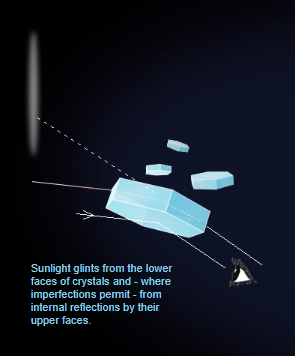OPOD - Ice & Water
OPOD - Ice & Water: Unveiling the Mysteries of Glints and Flashes
When it comes to atmospheric optics, the interplay between ice and water can create mesmerizing visual phenomena. One such example is the delicate 20° tall sun pillar and glitter path captured by Bill Purdy at Surf City, New Jersey. In this article, we will delve deeper into the captivating world of ice and water glints, caustics, and their intricate relationship with sunlight.
The Dance of Sun Glints
Both ice and water contribute to the creation of sun glints, albeit in different ways. Ice crystals, often plate-shaped and imperfect, have the ability to reflect sunlight from their lower faces. In some cases, internal reflections within the crystals can also contribute to glint formation. These glints can give rise to an illusion of an upwards pillar, creating a stunning visual spectacle.
On the other hand, water glints manifest themselves in a less obvious manner. When sunlight interacts with waves, near parallel rays are deviated through reflection. The shape and intensity of the waves play a crucial role in determining how these rays cluster and intersect, forming sheets of bright light known as caustics. Imagine a gigantic fairground distorting mirror that constantly shifts its shape with each passing moment, creating a dynamic display of shimmering beauty.
Unveiling the Secrets of Caustics
Caustics, those enchanting sheets of bright light formed by intersecting sun rays, hold a captivating secret. When caustics sweep across the eye, they create intense flashes on the wave surface. High-speed photography reveals even more intricacies of this phenomenon. Dimmer glints, appearing as pairs of rays, traverse the wave surface in a meandering fashion. Briefly, they find each other and unite to form a caustic flash before separating once more. These individual ray pairs are the building blocks of the mesmerizing caustics we observe.
The Glitter Path: A Symphony of Light and Water
As the eye intercepts the dancing bright caustics, it perceives them as bright flashes emanating from the waves. Collectively, these flashes form what is known as a glitter path. The height and width of the glitter path depend on the maximum water slope within the waves. It is this interplay between light and water that creates a symphony of glints and flashes, captivating observers fortunate enough to witness this natural spectacle.
A Glimpse into the Visual Symphony
The intricate dance of ice and water glints, caustics, and glitter paths is a feast for the eyes. It is a reminder of the breathtaking complexity that exists within our atmosphere. As sunlight interacts with ice crystals and waves, it creates a symphony of light that is both awe-inspiring and humbling.
To truly appreciate the beauty of atmospheric optics, it is essential to observe these phenomena firsthand. Whether it be a sun pillar reaching towards the heavens or a glitter path shimmering on the water's surface, these natural wonders remind us of the hidden marvels that surround us each day.
So next time you find yourself gazing at the sky or standing by the ocean, take a moment to immerse yourself in the enchanting world of ice and water. Marvel at the glints and flashes, and let yourself be captivated by the ever-changing dance of light and nature.

Ice - Water - Halo - Caustics
A delicate 20° tall sun pillar and glitter path at Surf City, New Jersey. Seen by Bill Purdy
Both are thousands or millions of sun glints, the pillar from ice, the glitter in a less than obvious manner from water.
©Bill Purdy, shown with permission.

Sunlight glints from the lower faces of crystals and - where imperfections permit - from internal reflections by their upper faces.
Large and therefore wobbly plate-shaped ice crystals glint their sunlight to give the illusion of an upwards pillar. The crystals might be imperfect and even dendritic rather than the perfect hexagons at left.
Sea glints are as from a gigantic fairground distorting mirror that shifts its shape with each passing moment.
Near parallel sun rays are deviated by reflection from the waves. Depending on the wave shape and intensity the rays may then cross and cluster to form sheets of bright light - caustics. This reflection action is similar to that when light enters the water - see here. The dancing bright and ever sharp curves on boat hulls are where they intersect the caustic sheets.
Caustics sweep across the eye. When they do, it sees an intense flash on the wave surface. High speed photography shows more. Pairs of dimmer glints meander across the wave surface; briefly find each other to unite to a caustic flash before separating once more. These are the individual ray pairs that form the caustics.

The eye intercepts dancing bright caustics and sees them as bright flashes from the waves. Collectively they form a glitter path. The glitter path height and width depends on the maximum water slope within the waves.
Note: this article has been automatically converted from the old site and may not appear as intended. You can find the original article here.
Reference Atmospheric Optics
If you use any of the definitions, information, or data presented on Atmospheric Optics, please copy the link or reference below to properly credit us as the reference source. Thank you!
-
<a href="https://atoptics.co.uk/blog/opod-ice-water/">OPOD - Ice & Water</a>
-
"OPOD - Ice & Water". Atmospheric Optics. Accessed on November 26, 2024. https://atoptics.co.uk/blog/opod-ice-water/.
-
"OPOD - Ice & Water". Atmospheric Optics, https://atoptics.co.uk/blog/opod-ice-water/. Accessed 26 November, 2024
-
OPOD - Ice & Water. Atmospheric Optics. Retrieved from https://atoptics.co.uk/blog/opod-ice-water/.